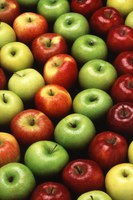Prairie Fare: Can You Trust “As Seen On TV” or Facebook Ads?
(Click an image below to view a high-resolution image that can be downloaded)
By Julie Garden-Robinson, Food and Nutrition Specialist NDSU Extension Service
As I was sorting through some clothes, I came upon one of those “blankets with sleeves” that were popular a few years ago, thanks to a TV commercial. I noticed that my older daughter had taken her blue one to college a few weeks ago. Maybe she expects her dorm room to be drafty.
Even our dogs received blue “blanket robes” that year. My daughter liked to dress our furry pets in their robes.
A few days ago, she called me from campus and asked for her “turban.” She likes to wrap her long hair in her towel-turban and twist it to dry her hair quickly.
Yes, we were influenced by yet another “as seen on TV” item. I found her pink turban. She will be quite a fashion icon in the dorm.
I was a night owl after having too much coffee in the afternoon a couple nights ago. I flipped through the TV channels and saw all kinds of food and health-related items being advertised. Fortunately, I didn’t feel compelled to grab my phone and credit card to order anything.
As we’ve learned in my house, some items advertised on TV or the internet are enjoyed, while other products end up in the back of a closet or in a junk drawer.
A while back, my ears perked when I saw another device advertised on TV. It promised to pressure cook and pressure can foods. I was waiting for the announcer to say that the device would drive my car to the grocery store and pick up the supplies. Maybe it would wash dishes, too.
The company making the product cited U.S. Department of Agriculture research. However, upon further investigation, I learned that this device was not approved for safe use with USDA methods.
In fact, the National Center for Home Food Preservation, which provides research-tested methods to the USDA, stated “we do not currently support the use of USDA canning processes in electric, multi-cooker appliances.”
Pressure cooking food to enjoy right away is a safe and efficient process that cuts time from food preparation. On the other hand, pressure canning requires special equipment and the use of tested methods. Pressure canning is used for low-acid foods such as meat, vegetables and many mixtures of foods.
How about those automatic water-bath canning systems made by reputable manufacturers? Yes, they are safe to use, but only with the formulations that come with the device.
Besides TV, social media sites such as Facebook and Pinterest increasingly are used to share information broadly with friends. If you are the friend doing the sharing, please do your homework. You don’t want to injure your friends, right?
Most recently someone asked me about a “new” practice called oven canning that was circulating on Facebook and among friends. Oven canning is not new, and it is not safe.
Researchers learned years ago that this practice was dangerous, even though it might sound like an easy solution to canning. The heat does not properly penetrate the glass jar to kill the microorganisms that might be present. Toxins (poisons) could form in foods that are improperly canned. The jars might explode in your oven, too.
If you are harvesting your garden, be sure to preserve the products safely. Add the recommended amount of bottled lemon juice or citric acid to tomatoes before canning. Blanch (heat-treat) the food as directed prior to freezing for best quality. Follow the directions on the canning lids because the plastics have changed in recent years.
If you have bountiful apples and like an occasional piece of apple pie or a turnover, here’s a recipe for making your own canned pie filling. This recipe calls for a special jelling agent that maintains its thickness after canning. It is available online or from specialty food stores. Using corn starch or another thickener is not advised in home canning.
Visit www.ag.ndsu.edu/food and search for “Let’s Preserve Fruit Pie Fillings” (FN 434) for more pie-filling recipes. Just add an 8- or 9-inch bottom and top crust and bake at 325 F for about 30 minutes, until the crust is slightly brown.
Since this is a nutrition column as well as a food safety column, here’s my nutrition advice for the week: stop at one piece of pie.
Homemade Canned Apple Pie Filling
1 tsp. ascorbic acid crystals or 6 vitamin C tablets per gallon of water (for pretreating apples; see directions)
3 1/2 c. fresh sliced apples
3/4 c. plus 2 Tbsp. granulated sugar
1/4 c. Clear Jel
1/2 tsp. cinnamon
1/2 c. cold water
3/4 c. apple juice
2 Tbsp. bottled lemon juice
1/4 tsp. nutmeg, if desired
Use firm, crisp apples. If apples lack tartness, use an additional 1/4 cup of lemon juice for each 6 quarts of slices. Wash, peel and core apples. Prepare half-inch-wide slices and place in water containing 1 teaspoon of ascorbic acid crystals or six 500-milligram vitamin C tablets in 1 gallon of water to prevent browning. Note: when making larger batches, place 6 cups of fresh fruit at a time in 1 gallon of boiling water. Boil each batch 1 minute after the water returns to a boil. Drain but keep heated fruit in a covered bowl or pot.
Combine sugar, Clear Jel and cinnamon in a large kettle with water and apple juice. If desired, nutmeg may be added. Stir and cook on medium-high heat until mixture thickens and begins to bubble. Add lemon juice and boil 1 minute, stirring constantly. Fold in drained apple slices immediately and fill pint or quart jars with mixture without delay, leaving 1-inch head space. Adjust lids and process immediately in a boiling-water-bath canner for 25 minutes at an altitude of 0 to 1,000 feet, 30 minutes at 1,000 feet, or 35 minutes for more than 3,000 feet.
(Julie Garden-Robinson, Ph.D., R.D., L.R.D., is a North Dakota State University Extension Service food and nutrition specialist and professor in the Department of Health, Nutrition and Exercise Sciences.)
NDSU Agriculture Communication - Sept. 8, 2016
| Source: | Julie Garden-Robinson, 701-231-7187, julie.garden-robinson@ndsu.edu |
|---|---|
| Editor: | Kelli Armbruster, 701-231-6136, kelli.armbruster@ndsu.edu |



